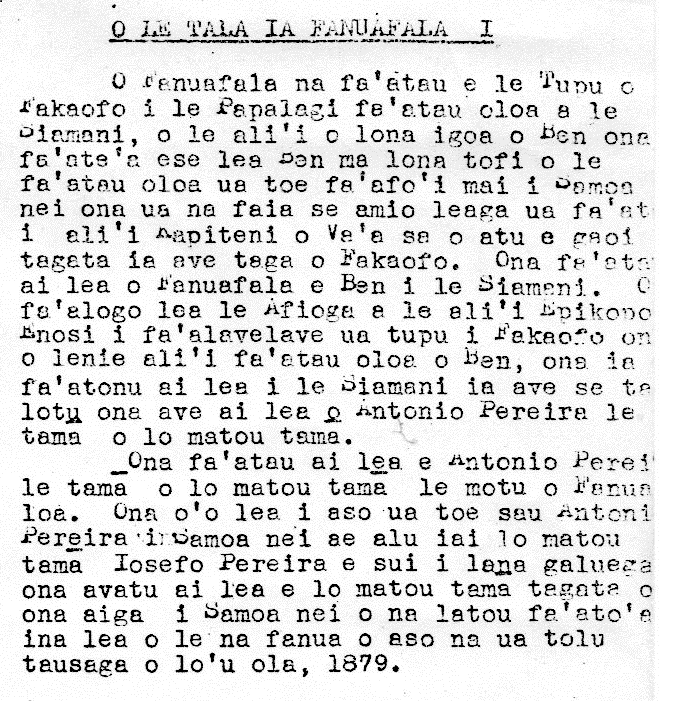Record of Lafaele Pereira
This document of record portrays the life and times of Lafaele Pereira and how the land in Tokelau came to be a part of the Pereira legacy. Again, I must advise that the translation is loosely interpreted, but it should be easy to understand the message’s basic intent. I do not know who typed it out nor what the documents’ original source was.
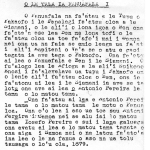
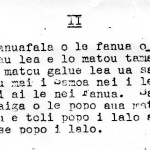

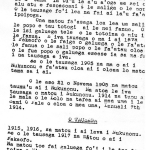
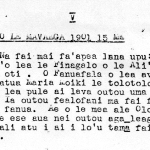

I
O LE TALA IA FANUAFALA
O fanuafala na fa’atau e le Tupu o Fakaofo i le fapalagi fe’atau oloa a le Siamani, o le ali’i o lona igoa o Ben ona fa’ate’a ese lea Ben ma lona tofi o le fa’atau oloa ua toe fa’afo’i mai i Samoa nei ona ua na faia se amio leaga ua fa’ato’a i ali’i Kapiteni o Va’a sa o atu e gaol tagata ia ave tega o Fakaofo. Ona fa’ata ai lea o Fanuafala e Ben i le Siamani. O fa’alogo lea le Afioga a le ali’i Epikopo Enosi i fa’alavelave ua tupu i Fakaofo ona o lenie ali’i fa’atau oloa o ben, ona ia fa’atonu ai lea i le Siamani ia ave se ta lotu ona ave ai lea Antonio Pereira le tama o lo matou tama.
Ona fa’atau ai lea e Antonio Pereira le tama o lo matou tama le motu o Fenualoa. Una o’o lea i aso ua toe sau Antonio Pereira i Samoa nei ae alu iai lo matou tama Iosefo Pereira e sui i lana galuega ona avatu ai lea e lo matou tama tagata o ona aiga i Samoa nei o na latou fa’ato’a ina lea o le na fanua o aso na ua tolu tausaga o lo’u ola, 1879.
TRANSLATION:
THE STORY OF FONUAFALA
The land was bought from King Fakaofo by a German merchant, a man named Ben, and then Ben was fired from his position as a merchant. He was sent back to Samoa because he committed an evil act and was punished by the captains of the ships who went to jail the people who took Fakaofo. Ben then mirrored Fanuafala in German. The Reverend Bishop Enos heard about the troubles that have happened in Fakaofo because of this merchant Ben, so he ordered the German to take a religious strike. then Antonio Pereira, our father’s father, was taken.
Then Antonio Pereira, our father’s father, bought the island of Fenualoa. Then Antonio Pereira came back to Samoa and our father Joseph Pereira went there to change his job and then our father gave his family members in Samoa what they had planted. but then that land of those days was three years of my life, 1879.
II
O Fanuafala o le fanua o le Siamani ona fa’atau lea e lo matou tama.
Ona matou galue lea ua sali le popo ma la’u mai i Samoa nei i le Siamani e tau totogi ai le nei Fanua. Sa faigata tele le faiga o le popo aua matou te o i luga o niu e toli popo i lalo aua ua le toe maua se popo i lalo.
TRANSLATION:
Fanuafala is the land of the German and our father bought it.
Then we worked to harvest the coconut and bring it to Samoa in Germany to pay for this land. It was very difficult to make the coconut because we had to go up to the coconut trees to push the coconut down because there were no more coconuts under it.
III
O TAGATA FAIGALUEGA
Ole faiga o le galuega le saliga o le popo. Sa fa’apenei ona fai ole tasi le afe popo o lona totogi e sefululua seleni.
O tupe ma oloa sa totogi ai.
1887 na amata ai ona fai le nei faiga sei o’o mai lava i le tausaga na fa’atau ai le fanua tausaga 1897.
Na amata ai ona fa’ato’a le Fanua. O le tama e igoa ia Sefa o ia e matua, o Lafaele, o Iosefo ma tama Tokelau o aiga o lo matou tinaa’o aso fo’i na o laiti Manuele ma atone e le’i matutua aua e matu teine e to’a lua le au ali’i nei. 1901 na malaga mai ai sefa i Samoa nei. 1905 na ma o ai ma la ma faneu i Nukunonu. 1913 na sau ai Iosefo i Samoa nei. Na matou o ese ma Fanuafala a ua opo uma i le toga niu.
O le fanua ole afa na fa’ato’a e le Siamani o tagata Kilipati sa ave atu i Samoa nei sa latou totoina Niu.
Ae o le tasi afa o le fanua o lea na matou fa’ato’a ina.
TRANSLATION:
WORKING PEOPLE
The method of work is the coconut palm. It was like this that one thousand coconuts was his salary of twelve shillings.
Money and goods were used to pay for it.
1887 he started doing this process until the year the land was bought in 1897.The Land began to be settled. The boy’s name is Sefa, his parents, Lafaele, Joseph and Tokelau are members of our family, Manuele and Atone are still young because they have three daughters. two of these men. In 1901 Sefa came to Samoa. 1905 we went with our family to Nukunonu. Joseph came to Samoa in 1913. We left with Fanuafala and we all hugged in the coconut grove.
Half of the land that was cleared by the Germans was taken by the Kilipati people to Samoa where they planted Niu.
But one half of the land we just got.
IV
Ole tausage 1893 na ou sau ai i Samoa nei i le A’oga 1894, 1895, 1896. O tausaga ia so ou aoga ai. Ae o le tausaga 1897 na ou alu ai i Tokelau. Na tusi mai lo’u tama ia tu’u ia a’u a’oga ae sei o alu atu e fesoasoani le saliga o le poto O le tausage fo’i lea na fai ai la’u fa’a ipoipoga.
Ona matou fa’asaga loa lea ua sali le popo e tau totogi ai le nei fanua. O le isi galuega tele o le totoina o niu i le fanua. E iva tausaga o ma i ai lava i Fakaofo o le faiga o galuega o le fa’ato le fanua o le sali popo o le fa’atau oloa o le fua popo o galuega eseese ia sa ma fe i na tausaga e iva.
Ae o le tausaga 1905 na ma o ai i Nukunonu e fa’atau oloa ai i oloaa lo matou tama sa i ai.
O le aso 21 o Novema 1905 na matou taunu’u ai i Nukunonu. Na atoa le iva tausaga o matou i Nukunonu. 1914 na tupu a le mala o le Lolo na tafea ai mea una i le Sami O fale o oloa o mea uma, Ianuali 7th 1914.
O TAUSAGA
1915, 1916, sa matou i ai lava i Nukunonu. Ae o le tausaga 1917 na matou o ai i Fakaofo.
Na matou toe fai galuega fo’i i le toe totoina o Niu na táfea i le Lolo. O aso fo’i na na maliu (oti) ai lo matou tama i Samoa nei 1916.
Ae o le 1918 na matou malaga mai ai i Samoa nei 23 o Setema na matou taunu’u mai ai i Samoa nei Oketopa, Novema, pesi le fa’ama ‘I oti.
TRANSLATION:
In 1893 I came to Samoa to study in 1894, 1895, 1896. These are the years I studied. But in 1897 I went to Tokelau. My father wrote to let me go to school and let him go and help me gain knowledge. This is also where I got married.
Then we faced the fact that the coconut is being sold to pay for this land. Another big job is planting coconuts in the field. We have been in Fakaofo for nine years, and we have been working in the fields of planting coconuts, selling products, and growing coconuts.
But in the year 1905 we went to Nukunonu to buy goods from our father’s property.
On the 21st of November 1905 we arrived at Nukunonu. We completed nine years in Nukunonu. 1914 happened when the disaster of the Flood washed away the goods in the Sea. The houses of goods of all things, January 7th 1914.
THE YEARS
1915, 1916, we were still in Nukunonu. But in the year 1917 we went to Fakaofo.
We also did work on replanting Niu that was washed away by the Flood. Those were the days when our father died in Samoa in 1916.
But in 1918 we came to Samoa on the 23rd of September and we arrived in Samoa in October, November, dying of the disease.
V
O LE MAVAEGA 1901 15 ME
Na fai mai fa’apea lana upu:
Afai po’o lea le finagalo o le Ali’i o le a ou oti. O Fanuafala o lea ave mo le Olomatua Maria Moiki le tolotolo ae o uta o lea pule ai lava outou uma le fanau. Ia outou fealofani ma fai fa’atasi lou tou fanua. e o le mea ale Olomatue ua vavae ese aua nei outou aga_leaga i ai. Na ou tali atu i ai i lo’u tama faitalia lava oe.
TRANSLATION:
THE DEPARTMENT 1901 15 MAY
He said this: If this is the will of the Lord I will die. Fanuafala is the carrier for Olomota Maria Moiki, but the cargo is the responsibility of all of you children. Love each other and share your land. This is what Olomatue has separated, so don’t be mean to it. I answered it to my father of your own free will. 1901 15 MAY
VI
Ae o le Tausaga 1914 na tupu ai le Lolo tele o aso na sa matou i ai i Nukunonu.
O le masina o Mati 15 na ou malaga ai i Fakaofo na ou nofo ai i nai aso toe fa’atu le fale o lo matou aiga na pa’u i le lolo. Una toe fai mai fo’i lea o le nei Mavaega ua fai mai ia te a’u:
Ia e malie ua ou toe manatu fa’apea olea ave ia Fanuafala mo le Olomatua ma lana fanau, ae o Fanua o lo’o i Samoa o lea ave mo outou. O oe o Iosefo o Maria Ma Kalesi ae o le fasi Fanua i Savalalo o la outou mea fa’atasi tou te pule uma i ai lau fanau uma ona ou tali lea fa’apea: Faitalia lava oe. Na fa’auma la’u galuega le faiga o le fale na pau i le lolo ona ou toe malaga lea Nukunonu, Apelila 24, 1914.
TRANSLATION:
But in the year 1914 there was a big flood during the days we were in Nukunonu.
In the month of March 15 I traveled to Fakaofo where I stayed for a few days rebuilding our family’s house that fell in the flood. Let me repeat what this Trustee has said to me:
It’s funny that I think that Fanuafala is taken for the Old man and his children, but the land in Samoa is for you. You are Joseph, Mary and Kalesi, but the piece of land in Savalalo is your joint property, and all your children have control over it, so I answer like this: It’s up to you.
I finished my work of building the house that fell in the flood and then I went back to Nukunonu, April 24, 1914.
